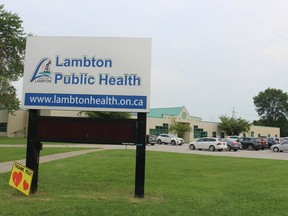There were 35 opioid related deaths in Sarnia-Lambton in 2023, according to preliminary data from the provincial coroner’s office, public health officials say.

There were 35 opioid related deaths in Sarnia-Lambton in 2023, according to preliminary data from the provincial coroner’s office, public health officials say.
Advertisement 2
Article content
That’s up slightly from the 32 probable and confirmed deaths in Lambton in 2022 — still considered preliminary and subject to change — but down from the 38 in 2021, and record-high 43 in 2020, county health unit officials said.
Article content
Lambton’s rate per 100,000 people — 26.1 in 2023 — continues to be above the provincial average, said health promotion supervisor Matt Butler.
Public Health Ontario’s interactive opioid tool this week didn’t yet have data for all of 2023, but the rate of deaths from opioids per 100,000 people in the province in 2022 was 16.7.
Lambton’s rate was 24, Butler said.
The provincial all-time-high rate, in 2021, was 19.1 deaths per 100,000 population, or 2,857 cases, provincial data shows.
“We’re dealing with a toxic drug supply,” Butler said about opioid drugs like fentanyl fueling the health crisis.
Advertisement 3
Article content
“We (also) have a vulnerable population that has complex needs (and requires) support from different agencies,” he said.
“So, it’s a complex issue that will take government collaboration and partnership from all levels of and community stakeholders.”
Recently community outreach nurses with public health, in partnership with other agencies, have started visiting clients in the community who can’t easily access other community services, to check on their well-being, he said.
Public health also has a harm-reduction clinic, needle exchange program, community sharps disposable bins, a Talk Early Talk Often program encouraging parents to talk to their children about substance-use harms, and a county drug and alcohol strategy, he said.
Advertisement 4
Article content
Hopes are to initiate actions on harm, supply and demand reduction for drugs and alcohol, as per the strategy, this year, he said.
Different service providers have been meeting to come up with action plans since the study was unveiled last springhe said.
“We should be seeing some of those action plans implemented hopefully this year,” he said
Butler also noted the significance of a plan to increase the number of withdrawal management beds at Bluewater Healthand the importance of transition beds at Ryan’s House.
Overall, the number of opioid-related deaths in the community is comparable to previous years, he said.
Hopes are the number continues to drop from the peak in 2020, he said.
There were 21 opioid-related deaths in the community in 2019, and 13 in 2018, health unit officials said.
All other years, dating back to 2005, there were 11 or fewer, Public Health Ontario records show.
Officials with the health unit urged drug users to start low, go slow; never use alone; avoid mixing drugs; and always carry overdose-reversing naloxone.
Article content